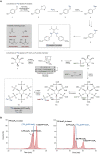Capillary electrophoresis mass spectrometry identifies new isomers of inositol pyrophosphates in mammalian tissues
- PMID: 36741535
- PMCID: PMC9847636
- DOI: 10.1039/d2sc05147h
Capillary electrophoresis mass spectrometry identifies new isomers of inositol pyrophosphates in mammalian tissues
Abstract
Technical challenges have to date prevented a complete profiling of the levels of myo-inositol phosphates (InsPs) and pyrophosphates (PP-InsPs) in mammalian tissues. Here, we have deployed capillary electrophoresis mass spectrometry to identify and record the levels of InsPs and PP-InsPs in several tissues obtained from wild type mice and a newly created PPIP5K2 knockout strain. We observe that the mouse colon harbours unusually high levels of InsPs and PP-InsPs. Additionally, the PP-InsP profile is considerably more complex than previously reported for animal cells: using chemically synthesized internal stable isotope references and high-resolution mass spectra, we characterize two new PP-InsP isomers as 4/6-PP-InsP5 and 2-PP-InsP5. The latter has not previously been described in nature. The analysis of feces and the commercial mouse diet suggests that the latter is one potential source of noncanonical isomers in the colon. However, we also identify both molecules in the heart, indicating unknown synthesis pathways in mammals. We also demonstrate that the CE-MS method is sensitive enough to measure PP-InsPs from patient samples such as colon biopsies and peripheral blood mononuclear cells (PBMCs). Strikingly, PBMCs also contain 4/6-PP-InsP5 and 2-PP-InsP5. In summary, our study substantially expands PP-InsP biology in mammals.
This journal is © The Royal Society of Chemistry.
Conflict of interest statement
There are no conflicts to declare.
Figures





Similar articles
-
Analysis of inositol phosphate metabolism by capillary electrophoresis electrospray ionization mass spectrometry.Nat Commun. 2020 Nov 27;11(1):6035. doi: 10.1038/s41467-020-19928-x. Nat Commun. 2020. PMID: 33247133 Free PMC article.
-
β-lapachone regulates mammalian inositol pyrophosphate levels in an NQO1- and oxygen-dependent manner.Proc Natl Acad Sci U S A. 2023 Aug 22;120(34):e2306868120. doi: 10.1073/pnas.2306868120. Epub 2023 Aug 14. Proc Natl Acad Sci U S A. 2023. PMID: 37579180 Free PMC article.
-
Capillary Electrophoresis Mass Spectrometry for Inositol (Pyro)phosphate Profiling.Methods Mol Biol. 2025;2972:95-113. doi: 10.1007/978-1-0716-4799-8_8. Methods Mol Biol. 2025. PMID: 40879981
-
Inositol pyrophosphates: why so many phosphates?Adv Biol Regul. 2015 Jan;57:203-16. doi: 10.1016/j.jbior.2014.09.015. Epub 2014 Oct 5. Adv Biol Regul. 2015. PMID: 25453220 Free PMC article. Review.
-
Biosynthesis and possible functions of inositol pyrophosphates in plants.Front Plant Sci. 2015 Feb 12;6:67. doi: 10.3389/fpls.2015.00067. eCollection 2015. Front Plant Sci. 2015. PMID: 25729385 Free PMC article. Review.
Cited by
-
Assigning the Absolute Configuration of Inositol Poly- and Pyrophosphates by NMR Using a Single Chiral Solvating Agent.Biomolecules. 2023 Jul 19;13(7):1150. doi: 10.3390/biom13071150. Biomolecules. 2023. PMID: 37509185 Free PMC article.
-
Functions, Mechanisms, and therapeutic applications of the inositol pyrophosphates 5PP-InsP5 and InsP8 in mammalian cells.J Cardiovasc Transl Res. 2024 Feb;17(1):197-215. doi: 10.1007/s12265-023-10427-0. Epub 2023 Aug 24. J Cardiovasc Transl Res. 2024. PMID: 37615888 Review.
-
Bacterial Pathogen Infection Triggers Magic Spot Nucleotide Signaling in Arabidopsis thaliana Chloroplasts through Specific RelA/SpoT Homologues.J Am Chem Soc. 2023 Jul 26;145(29):16081-16089. doi: 10.1021/jacs.3c04445. Epub 2023 Jul 12. J Am Chem Soc. 2023. PMID: 37437195 Free PMC article.
-
Inositol pyrophosphate catabolism by three families of phosphatases regulates plant growth and development.PLoS Genet. 2024 Nov 12;20(11):e1011468. doi: 10.1371/journal.pgen.1011468. eCollection 2024 Nov. PLoS Genet. 2024. PMID: 39531477 Free PMC article.
-
The phytase RipBL1 enables the assignment of a specific inositol phosphate isomer as a structural component of human kidney stones.RSC Chem Biol. 2023 Jan 27;4(4):300-309. doi: 10.1039/d2cb00235c. eCollection 2023 Apr 5. RSC Chem Biol. 2023. PMID: 37034402 Free PMC article.
References
LinkOut - more resources
Full Text Sources
Miscellaneous

